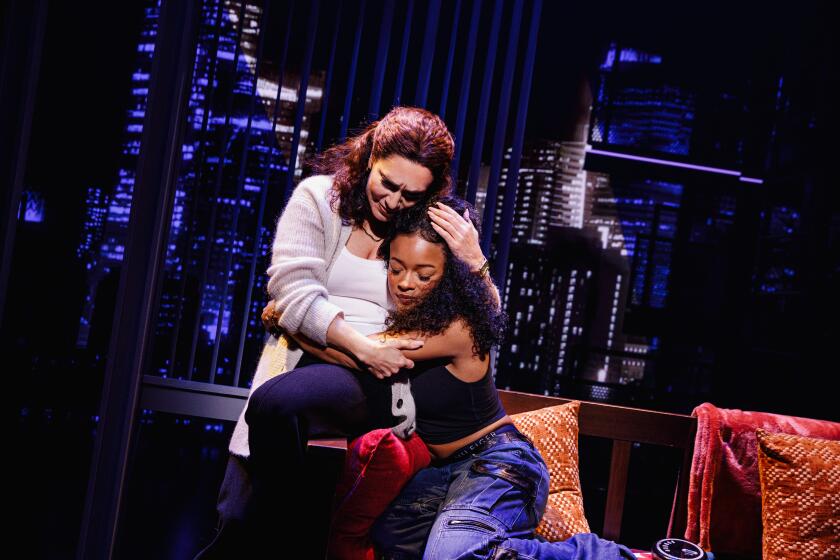Latin art museum gets a fresh look, new attitude
The Museum of Latin American Art in Long Beach has been like the downtrodden stepchild of Southern California’s glamorous museum family -- often ignored by critics, overlooked by art elites and forced to work overtime for every scrap of credibility it can muster.
Its location hasn’t helped. Far from the imposing hilltops and grand boulevards of its Los Angeles cousins, MOLAA is situated on a humble and colorless stretch of Alamitos Avenue, perhaps the last place you’d expect to find a respectable collection of fine art. Its nearby neighbors are a Laundromat, a Mexican restaurant and a Catholic Church, a mix that hasn’t changed much since the art house was founded more than a decade ago in a modest building that had all the curb appeal of a community center.
For the record:
12:00 a.m. June 6, 2007 For The Record
Los Angeles Times Wednesday June 06, 2007 Home Edition Main News Part A Page 2 National Desk 1 inches; 35 words Type of Material: Correction
Latin art museum: An article in Saturday’s Calendar section about the expansion of the Museum of Latin American Art in Long Beach identified Gregorio Luke as the museum’s executive director. Luke is the museum’s director.
This month, though, MOLAA has put on its glass slipper and is finally ready for the ball.
Expanded and remodeled with a dramatic, traffic-stopping facade, the museum is celebrating a grand reopening with a monthlong series of cultural events, including a fashion show, a family festival, a salsa dance party and a concert by critically acclaimed Mexican singer Lila Downs. The festivities kick off next Saturday with a black-tie banquet chaired and hosted by two Emmy-winning television personalities: Univision talk-show host Cristina Saralegui and CBS 2 News co-anchor Laura Diaz.
The inauguration of the expanded facility marks a milestone for the museum and for the often marginalized Latin American art it was designed to showcase.
“It’s an indescribable feeling of being a part of this historic moment,” says Gregorio Luke, the museum’s Mexican-born executive director. “I really think this museum is going to take Latin American art to a whole new level of awareness here.”
You could call MOLAA the little museum that could, totally upstaging the massive metropolis to the north. It’s almost a scandal that L.A. has no comparable Latino-themed museum -- not yet anyway.
MOLAA has succeeded largely due to the disciplined patronage of its founder and chief benefactor, Dr. Robert Gumbiner. But as the good doctor’s right-hand man, Luke has been a linchpin in implementing the museum’s mission.
Over lunch this week at his favorite steak house, Luke discussed his vision of a pan-Latin American culture that crosses national boundaries, a Bolivarian ideal he embraced only after coming to this country, ironically.
“I used to think only in terms of Mexico and Mexican culture,” says Luke, former cultural attache with the Mexican Embassy in Washington, D.C. “But for me, these years at MOLAA have suddenly made me appreciate the art of Peru and Ecuador, the music of Brazil, the pupusas of El Salvador and the mate of Argentina. I think the museum is going to be able to inspire this expanded sense of identity for everybody that comes to it.”
That unifying concept is captured in MOLAA’s soaring new architecture, as bold as some of the art inside. The contemporary facade, designed by Mexican architect Manuel Rosen, is composed of intersecting planes lifted high off the ground, representing those cultural bridges the museum is working to create. The building is skirted by cool pools of water and hardscapes of rock and agave plants, the source of tequila, Mexico’s most traditional liquor.
Luke calls it an oasis, and it’s an apt term. It’s hard not to feel your spirits lifted when you come upon the striking structure, set diagonally on a spacious corner lot that creates instant breathing room in its cramped urban environment. Finally, Latin American art has been given the space of beauty and dignity that it deserves. Luke hopes it will help attract a broader audience and give Latin American art an overdue recognition “as an equal partner at the table,” rather than something peripheral to European and U.S. art.
I’ve been coming to the museum for several years now and feel a sort of homegrown affection for it. While I was dating my wife, we attended a few special events at MOLAA, dancing salsa to a band from Havana and hearing Luke’s rapturous lecture on the Mexican rebozo.
Many mainstream museums feature live Latin music to attract a larger Latino audience. But at MOLAA, the music doesn’t feel like a promotional hook. It feels organically integrated with its setting, since music, art, cuisine, literature and fashion all fall within its exclusively Latino cultural mission.
Yet, by its crossbred nature, Latino culture always feels inclusive, Luke notes. By definition, the mestizo essence of Latin America is an amalgam of cultures and races -- white and black, mulatto and criollo, Asian and indigenous.
“When looking at Latin American art, you never get the feeling of looking at a foreign culture,” says Luke. “There’s always something there that’s familiar to you.”
Views from both sides of the border
One important element is missing from the artistic mission of MOLAA -- the art made in its own backyard. While the Long Beach museum focuses exclusively on work from south of the border, another exhibit opening today in Orange County highlights works about the U.S.-Mexico border made by artists living on both sides of it.
The Orange County Center for Contemporary Art in Santa Ana brings together 26 Mexican and U.S.-based Chicano painters and sculptors, half from each country, expressing their personal visions of the increasingly controversial borderline.
The title of the exhibition uses a Spanish slang term that, in this context, means a state of angst, conflict or consternation: “The Great Wall of Chinga.” The name was borrowed from a separate project with the same concept, sponsored by the Ministry of Culture, an L.A.-based arts collective. The ministry gave its blessing to the O.C. project, which was developed independently by artist Gregg Stone, a Realist artist whose own work focuses on the border.
As co-curator, Stone says he wanted to spotlight “new and upcoming artists whose works have never been shown in the United States.” But the show also features veterans, including Chicano artist Ricardo Duffy, who produced a large centerpiece. Among the most notable entries, Stone notes, is a “spectacular painting” of Mexicali by Mexican Realist Ramon Carrillo, whom he considers vastly underappreciated.
I don’t pretend to be an art critic, but it’s inspiring to see people using the border to explore connections rather than divisions.
“The Great Wall of Chinga,” curated by Gregg Stone and Barbara Thompson, Today-June 28. Orange County Center for Contemporary Art, 117 N. Sycamore, Santa Ana. For information, call (714) 667-1517 or go to www.occca.org.
--
Gurza covers Latino music, arts and culture. E-mail agustin.gurza@latimes.com with comments, events and ideas for this weekly feature.
--
(BEGIN TEXT OF INFOBOX)
In honor of MOLAA’s grand reopening
---
Some of the grand reopening events at the Museum of Latin American Art, 628 Alamitos Ave., Long Beach. For tickets and information, call (562) 437-1689 or reserve at www.molaa.org.
--
Black-tie gala: 6:30 p.m. next Saturday. Cocktails and a ribbon-cutting ceremony followed by a formal dinner, music and a fashion show. Limited tickets available. $250 to $500.
Family festival: noon to 4 p.m. June 10. Pose for a photo with Diego Rivera and Frida Kahlo. Listen to Aztec stories. Make percussion instruments and take salsa dance lessons. The festival also features music, dance, giant puppets (mojigangas), art workshops and museum tours. Free.
Lila Downs: 6:30 p.m. June 17. The critically acclaimed Mexican vocalist will be accompanied by a 12-piece band. Tickets: $65 to $75.
Latin Dance Party: 8 p.m. June 23. Two orchestras, Chalo y Sus Ache from Cuba and Desde Afuera from Venezuela, perform. Also, local vocalists Candi Sosa and Iris Cepeda. The evening includes a dance contest with prizes and salsa dance demonstration. Rusty on the moves? Practice in advance with classes every Tuesday. Tickets: $25 to $30.
More to Read
The biggest entertainment stories
Get our big stories about Hollywood, film, television, music, arts, culture and more right in your inbox as soon as they publish.
You may occasionally receive promotional content from the Los Angeles Times.





